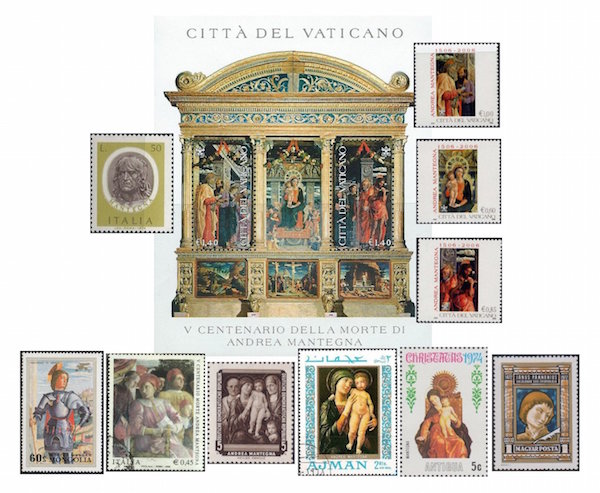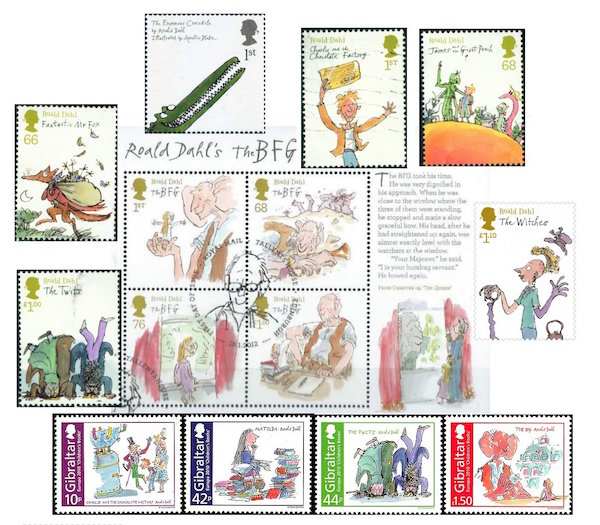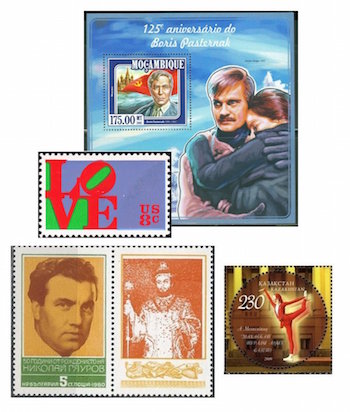The Arts on Stamps of the World — September 13
An Arts Fuse regular feature: the arts on stamps of the world.

By Doug Briscoe
We lead today with a very great artist who died on the 13th of September, Andrea Mantegna. Our birthday people include Clara Schumann, Arnold Schoenberg, Roald Dahl, Claudette Colbert, Maurice Jarre, and Nicolai Ghiaurov. And, of course, that’s not all.
Born about 1431 near Padua, Andrea Mantegna was apprenticed to the busy school of Francesco Squarcione, who seems to have instilled his love of ancient Rome into his pupil, although the two men had a falling out while Mantegna was still in his teens. The author of the Wikipedia article on Mantegna uses an elegant phrase that struck my ear: “His flinty, metallic landscapes and somewhat stony figures give evidence of a fundamentally sculptural approach to painting.” In 1460 he became court painter to Ludovico III Gonzaga of Mantua. My personal introduction to Mantegna was through the nine splendid tempera pictures of the Triumphs of Caesar he executed there by 1492. I saw them many years ago at Hampton Court Palace. (They had been bought by Charles I in 1628.) Mantegna died in Mantua on September 13, 1506. Now let us approach the stamps, shall we? The portrait stamp from Italy (one of many from a series of Italian artists, musicians, et al.) offers a likeness that comes from a posthumous funerary monument. The grand souvenir sheet from the Vatican City shows Mantegna’s San Zeno Altarpiece (1456-59); an accompanying issue gives us a closer look in three separate stamps showing details from each of the three panels. Beneath the souvenir sheet we have first a Mongolian stamp offering St. George (c1460). Next comes a detail from the “Court Scene” of the Camera degli Sposi (“bridal chamber”) in the Ducal Palace of Mantua; it shows Mantegna’s first patron in the city, the aforementioned Ludovico Gonzaga. The next pair of stamps, one from East Germany, the other from Ajman, reproduce the same work, The Holy Family with Saints Anne and John (1495-1505). The Antigua Christmas stamp presents the Madonna della Vittoria (1496). As for the last stamp, the Hungarian one, it comes with a little Arts Fuse anecdote. Back on August 29th, I showed this stamp in connection with the Croatian-Hungarian humanist poet Janus Pannonius. At the time I was quite unaware that the portrait derived from a Mantegna painting, The Martyrdom of Saint Christopher. The detail shows that Mantegna included his friend Pannonius, who was educated in Italy, as a tribute to his great learning. Pannonius, in turn, composed a poetic elegy for Mantegna.

The writings of the Baroness Marie von Ebner-Eschenbach (September 13, 1830 – March 12, 1916) are held in such high regard in her native Austria that she is found on three separate stamp issues, plus one from Germany. Indeed, she is seen as one of the foremost of late 19th century writers in the German language. The Baroness was born in her family’s castle in Moravia but was not afforded a proper education. At eighteen she married a military man and took up literature. In these efforts she was assisted by Franz Grillparzer. The first work to come before the public was a play, Maria Stuart in Scotland, produced in Karlsruhe in 1860. Ebner-Eschenbach went on to write numerous other dramas before turning to the novel. Her books are characterized by deep psychological insights, masterly character portraits, and wit, all expressed in an elegant style. At the age of 70 she received an honorary doctorate from the University of Vienna. Not in need of income, she donated her earnings to a fund for struggling writers.
The Dutch theologian Nicolaas Beets (13 September 1814 – 13 March 1903) earns a place on Arts on Stamps of the World for his poetry and fiction. Using the pseudonym Hildebrand, Beets wrote Byronic poetry while still a student. Beets’ most famous work is Camera Obscura (1839), a three-volume collection of interconnected stories and short novels. A minister from 1874, Beets became a professor of church history at the University of Utrecht in 1884.
Julian Tuwim (September 13, 1894 – December 27, 1953) was an important Polish poet who also wrote children’s lyrics. Born in Lódz into a family of assimilated Jews, he was educated there and at Warsaw University. He wrote about city life, often satirically, with his work often appearing in cabarets. Indeed he founded a cabaret called Picador in 1918. One of his most highly regarded burlesques bears the title The Ball at the Opera (Bal w Operze, 1936). Tuwim escaped to Romania when World War II broke out, moving from there to France, Portugal, Brazil, and the United States, where he lived from 1942 to 1946. A music lover, Tuvim was a close friend of Arthur Rubinstein, whose sister Jadwiga had been a childhood friend of Tuwim’s mother. He also translated Pushkin and other Russian poets into Polish.
Generally acknowledged to have been one of the greatest pianists of the 19th century, Clara Schumann (1819 – 20 May 1896) was married to Robert Schumann, much against the wishes of her father, at the age of 21. Their happy marriage lasted only until his death in 1856. (Three of their grown children also died before Clara did.) She had written a fair amount of music, including a piano concerto and a piano trio, as a young woman but composed very little after Robert’s death. She was very close with Brahms—perhaps even romantically involved—and with the violinist Joseph Joachim.
Given Clara’s detestation of the music of futurists like Liszt and Wagner, she probably would not have had much liking for the works—early or late—of her countryman Arnold Schoenberg (1874 – 13 July 1951). His promise was noted by such figures as Mahler and Richard Strauss, and he had taken lessons from Alexander von Zemlinsky, whose sister Mathilde became Schoenberg’s first wife in 1901. He gradually broke away from tonality in his compositions and developed his twelve-tone system in 1921. He had converted to Christianity in 1898, but reverted to Judaism in 1933, a year before leaving Germany for, eventually, the United States. (His first teaching post was at Boston’s Malkin Conservatory, and he became a citizen in 1941.) Schoenberg was a triskaidecaphobe who was horrified when he was told that the title of his opera Moses und Aaron contained thirteen letters. It thus became Moses und Aron. He died on a Friday the 13th.

Celebrated American film actress Claudette Colbert (September 13, 1903 – July 30, 1996) has no stamp in her honor, but her image appears on one devoted to the great director Frank Capra. The stamp takes the famous hitchhiking scene from It Happened One Night (1934), for which Colbert won the Best Actress Academy Award. Born in France, Émilie Claudette Chauchoin, called “Lily”, came with her family to Manhattan in 1906. She had an advantage in learning English from her grandmother, who had lived in the Channel Islands. Longing to be a painter, Lily studied art and practiced it as a hobby in later years. After her first stage appearance at 15, she adopted her grandmother’s maiden name Colbert as her stage name. She starred in a couple of films—one of them was The Big Pond (1930) with yesterday’s birthday subject Maurice Chevalier—before her career-making appearance in Cecil B. DeMille’s 1932 epic The Sign of the Cross. Colbert was the highest-paid movie star in the years 1938 and 1942. The old joke about actors insisting on being filmed on their “good” sides was a reality for Colbert. She always demanded that her face be filmed from the left on account of her nose having been broken in childhood.
The Greek theater director Karolos Koun (September 13, 1908 – February 14, 1987) was born and educated in Ottoman Turkey. His mother was Greek, his father Polish-Jewish. His stagings of Aristophanes earned him a reputation throughout Europe, and in 1942 he founded the Art Theater and drama school in Athens. Later he introduced works by Brecht, Pirandello, Ionesco, and others to Greek audiences.

Last year was the centenary of Roald Dahl’s birth. In 2010 and 2012 Great Britain and Gibraltar has issued a goodly number of postage stamps citing the author’s enormously popular books for children. The parents of Roald Dahl (13 September 1916 – 23 November 1990) had come (separately) from Norway to Wales, and Roald spoke Norwegian before he spoke English. As a World War II flying ace, Dahl was asked by C.S. Forester to provide notes for a story Forester was writing for the Saturday Evening Post, but when Forester saw the result he had it printed unchanged. This was Dahl’s first published work. He was married to the actress Patricia Neal from 1953 to 1983. He wrote a number of screenplays, including one for the James Bond vehicle You Only Live Twice.
On the subject of film, French composer Maurice Jarre (13 September 1924 – 28 March 2009) was one of the biggest names in the business, with a list of credits including Eyes Without a Face (1959), The Longest Day (1962), The Train (1964), The Man Who Would Be King (1975), The Tin Drum (1979), The Year of Living Dangerously (1982), A Passage to India (1984), Mad Max Beyond Thunderdome (1985), Fatal Attraction (1987), and Dead Poets Society (1989). I might have shown the British Lawrence of Arabia stamp for Jarre, but since we’ve already seen that one twice, once for the birthday of David Lean, and again for Peter O’Toole, I thought I’d use a souvenir sheet from Mozambique instead. It was actually issued to honor Boris Pasternak, but uses the images of Omar Sharif and Julie Christie from the movie for which Jarre’s score won an Oscar, a Grammy, and a Golden Globe.

American pop art exponent Robert Indiana (born Robert Clark on September 13, 1928) is best known for the “LOVE” print he created for the Museum of Modern Art’s Christmas card in 1965. This design grew to be so popular that it was used for the first (1973) of the long (too long) series of “love” stamps issued by the USPS. Born in the state of, yes, Indiana, he studied at the Art Institute of Chicago and in in Maine and Edinburgh. He settled in New York City on his return to the U.S. in 1954. In addition to his work as a graphic artist, Indiana has designed theater sets and costumes, notably for a 1976 production by the Santa Fe Opera of Virgil Thomson’s opera The Mother of Us All. Andy Warhol made two short films about him. The “LOVE” design had a rebirth of sorts in 1977, when Indiana created a Hebrew version with the four letter word Ahava for Jerusalem’s Israel Museum Art Garden, and again in 2008, when the artist made a similar image using the word “HOPE” as a means of raising financial support for Barack Obama’s first presidential campaign. The associated merchandise brought in over $1,000,000. (I couldn’t resist placing the “LOVE” stamp next to Zhivago and Lara.)
Bulgarian basso Nicolai Ghiaurov (1929 – 2 June 2004) was one of the most admired of operatic basses, noted particularly for his work in Mussorgsky and Verdi. As a child Ghiaurov could play the violin, piano, and clarinet. He won two vocal competitions in Paris and Prague in 1955 and made his stage debut that same year in Sofia. La Scala and Covent Garden debuts followed in 1959 and 1962, the Met in 1965. He was married to the soprano Mirella Freni (his second wife) from 1978 until his death.
Azerbaijani composer Arif Malikov (or Melikov) (b. 1933) was born in Baku and came to fame just a few years after his graduation from the Baku Conservatory, when his ballet Legend of Love was staged at the Kirov (1961). It was a great success and received many performances throughout the Soviet Union and Eastern Europe. He has written two other ballets and at least six symphonies, besides symphonic poems and film music. He currently teaches at the Azerbaijan State Conservatory. His stamp (at lower right) comes from a sheet of ballet stamps issued by Kazakhstan in 2009.
I find no stamps for Jan Brueghel the Younger (13 September 1601 – 1 September 1678), Sherwood Anderson (September 13, 1876 – March 8, 1941), J. B. Priestley (13 September 1894 – 14 August 1984), or Mel Tormé (September 13, 1925 – June 5, 1999).
It should be also noted that today is the one hundredth anniversary of the birth of the fine American composer Robert Ward (September 13, 1917 – April 3, 2013).
A graduate of the University of Massachusetts with a B.A. in English, Doug Briscoe worked in Boston classical music radio, at WCRB, WGBH, and WBUR, for about 25 years, beginning in 1977. He has the curious distinction of having succeeded Robert J. Lurtsema twice, first as host of WGBH’s weekday morning classical music program in 1993, then as host of the weekend program when Robert J.’s health failed in 2000. Doug also wrote liner notes for several of the late Gunther Schuller’s GM Recordings releases as well as program notes for the Boston Classical Orchestra. For the past few years he’s been posting a Facebook “blog” of classical music on stamps of the world, which has now been expanded to encompass all the arts for The Arts Fuse.
